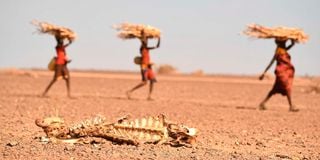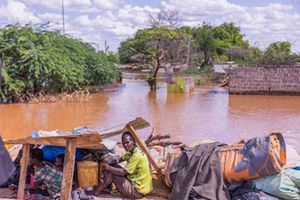La Niña likely to worsen food crisis in Kenya, warns FAO

Women carrying firewood walk past a carcass of a cow in Loiyangalan, Marsabit County, in Kenya on July 12, 2022.
What you need to know:
- Typically, La Niña leads to drier-than-usual conditions in some parts of the country, especially in the eastern and southeastern regions.
Kenya is among the countries whose food systems are expected to face significant disruption due to the La Niña weather pattern, which is forecast to impact global climates through March 2025.
La Niña is a natural weather pattern that happens when the sea surface temperatures in the central and eastern parts of the Pacific Ocean become cooler than usual. This is the opposite of El Niño, which is when the sea surface temperatures in the same area are warmer than normal.
Typically, La Niña leads to drier-than-usual conditions in some parts of the country, especially in the eastern and southeastern regions. This can lead to droughts, which can impact agriculture, water supply, and food security. On the other hand, El Niño, with its warmer ocean temperatures, often brings heavier rains to Kenya, which can lead to floods and landslides.
According to the latest bi-annual report from the Food and Agriculture Organization (FAO) and the World Food Programme (WFP), La Niña is likely to exacerbate drought conditions in Kenya, Somalia and Ethiopia, with these extreme weather events posing a serious threat to already vulnerable food systems, thus putting millions of people at increased risk of hunger.
The report titled Hunger Hotspots – FAO-WFP Early Warnings on Acute Food Insecurity, issued last week by the UN agencies, classifies 16 hunger hotspots where acute food insecurity is projected to worsen from November 2024 to May 2025, with climatic hazards pushing millions of people to the brink of starvation.
Based on the report, a total of 22 countries and territories are classified as "hunger hotspots," where acute food insecurity is expected to worsen due to a combination of conflict, economic instability, and climate shocks during the outlook period. These hotspots include 14 countries and two regional clusters, covering a total of 22 nations. Sudan, Palestine, South Sudan, Haiti, and Mali are identified as the highest-priority hotspots, while Chad, Lebanon, Myanmar, Mozambique, Nigeria, Syria, and Yemen are classified as ‘very high concern’.
Newly added to the list since May 2024 are Kenya, Lesotho, Namibia, and Niger, while Burkina Faso, Ethiopia, Malawi, Somalia, Zambia, and Zimbabwe remain on the list of hunger hotspots.
Apart from the escalating conflict, particularly in the Middle East, and economic stressors, the report highlights climatic hazards that are pushing people to the brink of starvation.
The report specifically draws attention to the famine in the Zamzam camp in North Darfur and the risk of famine in other areas of Sudan. It also highlights the enduring risk of famine in Palestine (Gaza Strip) and catastrophic levels of acute food insecurity in Haiti, Mali and South Sudan. The report warns that without immediate humanitarian action and efforts to overcome severe access constraints and resolve ongoing conflicts, further starvation and death are likely.
According to QU Dongyu, FAO director-general, to save lives and prevent acute hunger and malnutrition, there is urgent need for a humanitarian ceasefire to restore access to and availability of highly nutritious food, including revitalising local food production.
“But this alone is not enough; we need longer-term stability and food security. Peace is a pre-requisite for food security. Without peace and stability, farmers cannot grow food, harvest, or sustain their livelihoods,” he added.
“It’s time for world leaders to step up and work with us to reach the millions of people at risk of starvation – delivering diplomatic solutions to conflicts, using their influence to enable humanitarians to work safely, and mobilising the resources and partnerships needed to halt global hunger in its tracks,” said Cindy McCain, WFP executive director.





